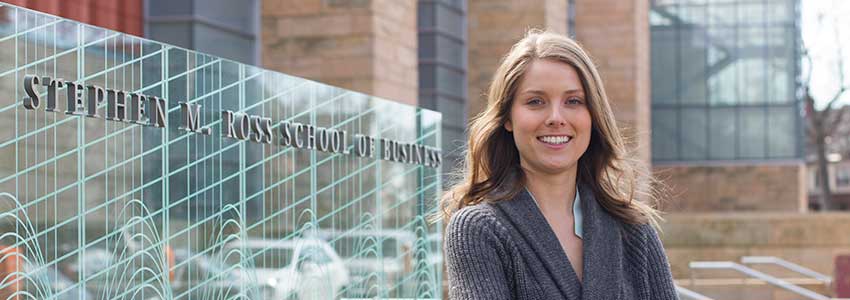Linda’s first visit to scope out graduate programs at U-M was a doozy.
“I spent a year in the social psychology program on scholarship from my undergraduate institution in Germany and I really loved getting a glimpse of graduate student life. I was the same age as many people starting grad school, so I paid closer attention than I might have otherwise. I was impressed that students were trusted and allowed to pursue their own research project and given the resources to do so,” she recalls. Linda also liked that U-M doctoral programs involve a lot of coursework to deepen the learning experience. This intensive opportunity to assess U-M’s programs significantly shortened her list of potential research universities in North America, and she says, “I already had connections here and knew this would be a good fit.”
She’s shifted gears somewhat now that she’s a Wolverine. She says, “While I still love social psychology, and it still informs my research, I wanted to feel that what I was researching was readily more applicable.” Marketing seemed a better application for her: “Half of marketing at this level represents numbers and data sets and the other half is psychology, human behavior, and qualitative work or experiment in the lab. That’s what I wanted to do.”
And she’s doing it. Linda’s dissertation focuses on the role of serving food, and dissects how two market variables, self-service and serving size specifications, can nudge consumers toward healthier decisions. Her first essay situates serving food in an attribution framework and reveals how being served (instead of serving oneself) allows consumers to reject responsibility and feel less poorly for their eating decisions, and how this process encourages unhealthy eating. She describes, “Eating out has grown in popularity, but people eat much less healthily when they do. We were curious if, on average, when people eat out and are served by someone else, might this allow them the freedom to splurge on unhealthy foods, feeling less responsible for their consumption and less guilty for eating this food and then allow them to choose an unhealthy option and an unhealthy portion of that option.”
Her second essay takes a motivated reasoning perspective on serving size specifications on food packages and examines how posting larger serving sizes (as proposed by the FDA) may provide consumers with a sought-after justification for large helpings, reducing guilt and increasing consumption. She says, “Portion sizes are growing and people eat more from larger portions than from smaller portions, so that’s a problem. But what happens at home, where people have the chance to make their portions smaller more easily? Here, they might use serving size information suggested on the package, as regulated by the FDA. So, studying the impact of this information on consumers is critical.”
She maintains, “Besides offering novel theoretical implications, this work informs policy, suggesting actionable interventions to enhance consumer health and wellbeing. When I arrived here, I knew I wanted to do research that is primarily focused on consumer welfare and well-being instead of just helping businesses make more money. I work with two faculty members doing research in green sustainable decisions and eating behaviors. We got together as a trio to brainstorm something in the realm of eating behavior and nudges, things that automatically push or nudge people toward a better decision.” Because consumer well-being topics have universal interest, they often are picked up by popular media once published, particularly since it is relatively easy to talk about these subjects to non-academics. Her work is currently in the process of being published and she hopes her research has broad appeal.
Grad school has been a strong, steady course for Linda. “Everything has been the right decision. I’ve faced problems that every grad student faces: essentially it’s our job to come up with ideas and scientifically test whether or not they are correct, but often the idea just doesn’t pan out – and when failure happens a few times in the row, it can be hard to take. It often takes a group of older grad students to say ‘Hey, we’ve been there, stick with it.’ I am super lucky that people within my program are pretty close. We hang out a lot, watch movies, play board games, and have potlucks. I have wonderful friends; they all are or were Ph.D. students in different programs, and it’s a relief to see that everyone is in the same boat, that we all struggle with different versions of the same things.”
Linda is from Germany, and the business school has been a good fit for her. She says, “The Ph.D. student community in the business school is extraordinarily international: as a foreigner we have more of a majority. When I applied, over 50% of the doctoral students here were international.” She laughs when she says, “This means I’m not the only person in the room who doesn’t really know what to do for Thanksgiving. Really, though, it gives us a chance to learn about other cultures, giving us more reasons to celebrate. There’s a tradition in our department to celebrate a joint Fourth of July/Canada Day, and when Germany was doing well in the World Cup last year, we celebrated that. The food is very diverse at our potlucks! It makes it easier from the standpoint that everyone can relate to this feeling that we left everybody in our lives behind so this experience better be good…” And thankfully, it is!

